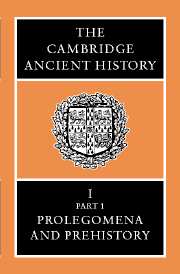Book contents
- Frontmatter
- Contents
- List of Maps
- List of Tables
- List of Text-figures
- Preface
- Chapter I The Geological Ages
- Chapter II Physical Conditions in Eastern Europe, Western Asia and Egypt Before the Period of Agricultural and Urban Settlement
- Chapter III Primitive Man in Egypt, Western Asia and Europe in Palaeolithic Times
- Chapter IV The Evidence of Language
- Chapter V The Earliest Populations of Man in Europe, Western Asia and Northern Africa
- Chapter VI Chronology
- Chapter VII (a) The Earliest Settlements in Western Asia from the Ninth to the End of the Fifth Millennium B.C.
- Chapter VII (b) Anatolia Before 4000 B.C.
- Chapter VIII The Development of Cities From Al-‘Ubaid to the End of Uruk 5
- Chapter IX (a) Predynastic Egypt
- Chapter IX (b) Palestine During the Neolithic and Chalcolithic Periods
- Chapter IX (c) Cyprus in the Neolithic and Chalcolithic Periods
- Chapter X The Stone Age in the Aegean
- Bibliographies
- Index to Maps
- General Index
- Maps
Chapter VII (a) - The Earliest Settlements in Western Asia from the Ninth to the End of the Fifth Millennium B.C.
Published online by Cambridge University Press: 28 March 2008
- Frontmatter
- Contents
- List of Maps
- List of Tables
- List of Text-figures
- Preface
- Chapter I The Geological Ages
- Chapter II Physical Conditions in Eastern Europe, Western Asia and Egypt Before the Period of Agricultural and Urban Settlement
- Chapter III Primitive Man in Egypt, Western Asia and Europe in Palaeolithic Times
- Chapter IV The Evidence of Language
- Chapter V The Earliest Populations of Man in Europe, Western Asia and Northern Africa
- Chapter VI Chronology
- Chapter VII (a) The Earliest Settlements in Western Asia from the Ninth to the End of the Fifth Millennium B.C.
- Chapter VII (b) Anatolia Before 4000 B.C.
- Chapter VIII The Development of Cities From Al-‘Ubaid to the End of Uruk 5
- Chapter IX (a) Predynastic Egypt
- Chapter IX (b) Palestine During the Neolithic and Chalcolithic Periods
- Chapter IX (c) Cyprus in the Neolithic and Chalcolithic Periods
- Chapter X The Stone Age in the Aegean
- Bibliographies
- Index to Maps
- General Index
- Maps
Summary
I. GEOGRAPHY, TERMINOLOGY AND CHRONOLOGY
The scene of man’s first emergence as a food-producer as opposed to the countless millennia of his existence as a foodgatherer during the Palaeolithic period, an event frequently alluded to as the ‘neolithic revolution’, was that part of southwest Asia which is usually described as the Near East, or in the terminology of some the Near and Middle East.
Even before the last glaciers had retreated from northern Europe, man in south-west Asia had embarked on a momentous course which was to lead slowly but inexorably to the development of civilization, a higher and more efficient form of living than had been practised during the long aeons of the Palaeolithic period. These changes towards the domestication of animals and plants, the conservation and eventually the production of food no doubt came slowly. They were not accomplished overnight, or due to a sudden discovery or the arrival of new ethnic elements bringing a higher culture from ‘elsewhere’. On the contrary, they were the culmination of a process that had started long ago, we assume, with the appearance of modern man, Homo sapiens, at the beginning of the Upper Palaeolithic. Improved technical skills in the production of tools and weapons with which to catch and kill his quarry, the manufacture of clothing, nets and matting, the construction of tents and huts, a greater cohesion of hunting groups and the first rise of semipermanent hunting-camps, all marked important steps forward, well in advance of his predecessor, Neanderthal man. In no single field were the changes more marked than in the field of religion; slowly art developed, first sculpture in the form of statuettes of a goddess of fecundity, next the arts of engraving and painting, to culminate in the unsurpassed cave paintings of such sites as Lascaux, Altamira, Font de Gaume, Niaux, Pech Merle and a host of others. Upper Palaeolithic man in the later stages of the Ice Age is emerging as an individual, deeply religious, a craftsman and artist of no mean order, and a most successful hunter, but bound by his environment and utterly dependent on the food supplies available.
- Type
- Chapter
- Information
- The Cambridge Ancient History , pp. 248 - 303Publisher: Cambridge University PressPrint publication year: 1970



